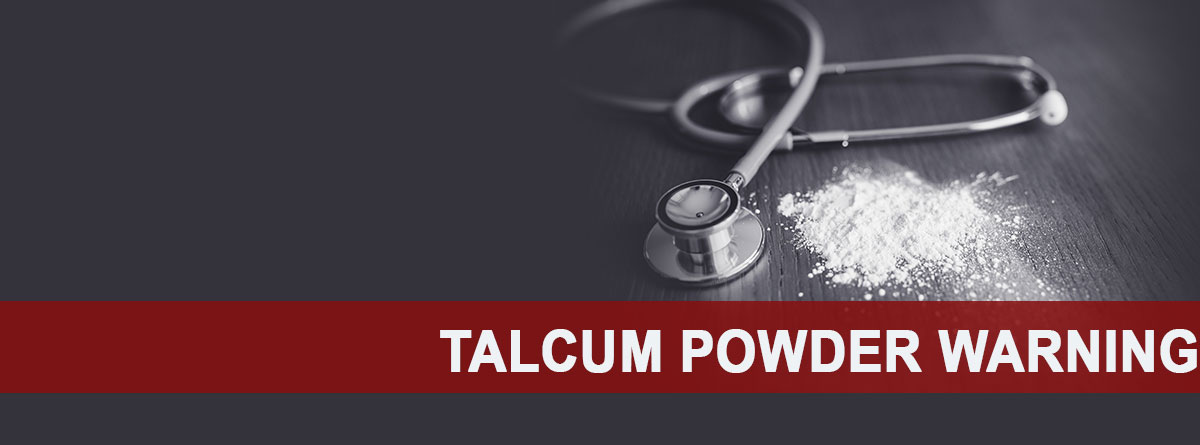Talcum Powder
Talcum powder, derived from talc, a hydrated magnesium silicate, has been has seen almost ubiquitous use by families in the United States for nearly 130 years. Johnson & Johnson first introduced their Baby Powder in 1893. For the last century Johnson’s Baby Powder has been a top selling product for this global behemoth. Though promoted initially as a way to absorb moisture and odor from babies, it soon was also marketed to adult women as means to keep their skin feeling fresh under names such as “Shower-to-Shower”.
Concerns over the potential link between talcum powder and ovarian cancer have been around for decades. In 1971 researchers found talc particles embedded in ovarian and cervical tumors. Ten years prior to that a study found that talc can translocate from the exterior of a woman’s genitals to her ovaries. Harvard researchers further confirmed the findings of the 1971 study in 1982, when they produced a study finding a 92% increased risk ovarian cancer per genital talc use. In 1992, a group from Johns Hopkins found that applying talc to the genitals using a sanitary napkin increased a woman’s risk of ovarian cancer by 379%.
Link to Ovarian Cancer
The link between talcum powder products and ovarian cancer has been confirmed in more than nine separate studies, culminating with the 2008 “Gates Study’ by the National Cancer Institute, which led the American Cancer Society to formally pronounce the relationship. Most recently, the 2011 study by another team at Harvard (in conjunction with the NCI), which again found a dose-response relationship between talc use on the genitals and ovarian cancer. This 4,000-woman study revealed a 200%-300% increased risk of cancer from perineum talc use.
Johnson & Johnson has always maintained that the talc contained in their Baby Shower and Shower-to-Shower is safe, even in the face of research indicating the contrary. Researchers had further found that the products could also contain asbestos. In 2019 an FDA test confirmed the presence of chrysotile asbestos fibers in J&J Baby Powder and the company was forced to recall some 33,000 bottles.
Current Status of Litigation
The first state court trial to take place with respect this issue occurred in South Dakota in 2013. A jury determined that J&J failed to adequately warn women about the risk of ovarian cancer from baby powder. In 2016, juries found for the plaintiffs in several cases awarding plaintiffs $72 million, $55 million, $70 million, and $110 million. August of 2017 saw a California jury award $417 million to the injured party. Another massive verdict was handed out by a St. Louis jury, that awarded 22 women $4.7 billion, with new verdicts following in the past several years.
In October of 2016, talcum powder claims were centralized into MDL #2738 and transferred to the District Court of New Jersey, to be overseen by Chief US District Judge, Freda L. Wolfson. In a huge win in late April 2020, Judge Wolfson issued her Daubert opinion, determining expert opinions offered by plaintiffs were reliable and sound, allowing more than 16,000 cases to move forward.
Following the October 2020 announcement of a $100 million agreement to settle roughly 1,000 claims, J&J further announced the company would be setting aside $3.9 billion for talc-related litigation in a February 2021 regulatory filing. The untold attempts by J&J to sidestep paying the injured claimants has been unrelenting over the past few years with new iterations of the ‘Texas Two-Step’ bankruptcy attempts that continue to be defeated in court as they find new ways to delay payment. The continuous delays have pushed forward state court actions for both ovarian cancer and mesothelioma cases. While there have been both defense and plaintiff verdicts, in April 2024 a Chicago jury ordered J&J to pay a woman who developed meso after using their talc product $45 million in damages. In January 2024, J&J announced a $700 million settlement with several states over its alleged deceptive marketing practices in association with the products.
Links:
- https://obgyn.onlinelibrary.wiley.com/doi/abs/10.1111/j.1471-0528.1971.tb00267.x
- https://www.ncbi.nlm.nih.gov/pubmed/7083145
- https://www.sciencedirect.com/science/article/abs/pii/0090825892904852
- https://www.ncbi.nlm.nih.gov/pubmed/18768514
- https://www.reuters.com/article/us-johnson-johnson-talc/jj-recalls-33000-bottles-of-baby-powder-as-fda-finds-asbestos-in-sample-idUSKBN1WX1L3
Litigation Links:
- https://rapidcityjournal.com/news/south-dakota-jury-ties-talc-powder-to-cancer-risk/article_78bd7792-b78c-5adb-b684-e6b2c2db10ed.html
- https://www.cnbc.com/2017/05/05/johnson-johnson-ordered-to-pay-110-million-in-us-talc-powder-trial.html
- https://www.reuters.com/article/us-johnson-johnson-cancer-lawsuit/jj-ordered-to-pay-417-million-in-trial-over-talc-cancer-risks-idUSKCN1B121D
- https://www.wsj.com/articles/j-j-hit-with-550-million-jury-verdict-in-baby-powder-suit-1531435569
- https://www.law.com/njlawjournal/2020/04/27/judges-expert-ruling-obliterates-jjs-defense-of-junk-science-in-talc-trials/?slreturn=20200413143926
- https://www.forbes.com/sites/danielcassady/2020/10/05/johnson–johnson-to-pay-100-million-in-baby-powder-settlement/?sh=587c3ef172c9
- https://www.asbestos.com/news/2021/02/24/johnsons-billions-talc-settlements/
- https://www.forbes.com/sites/caileygleeson/2024/04/20/court-orders-johnson–johnson-and-kenvue-to-pay-45-million-in-talcum-baby-powder-lawsuit/?sh=625751245a6c
- https://www.reuters.com/business/healthcare-pharmaceuticals/jj-pay-700-million-settle-states-talc-marketing-probe-bloomberg-news-2024-01-08/


